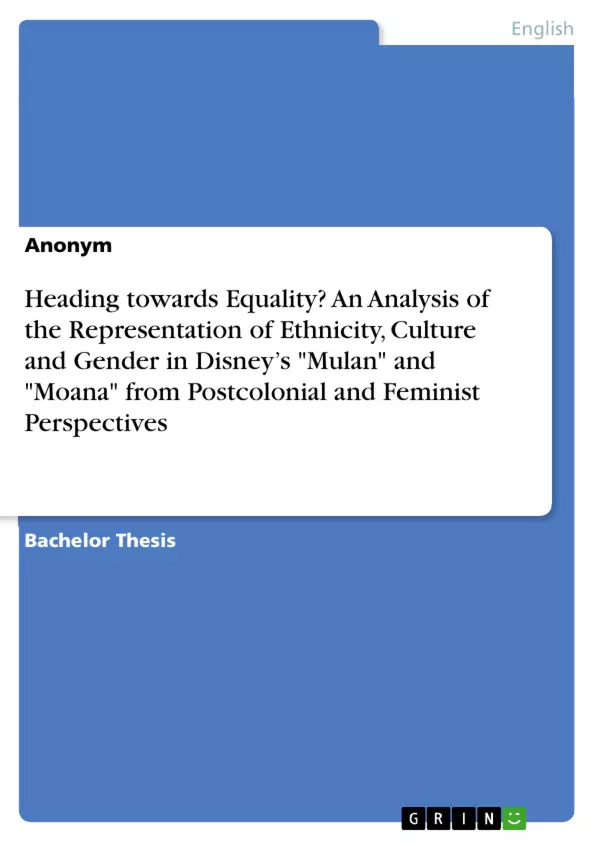
Heading towards Equality? An Analysis of the Representation of Ethnicity, Culture and Gender in Disney’s "Mulan" and "Moana" from Postcolonial and Feminist Perspectives
Bachelorarbeit, 2019
62 Seiten, Note: 1,0
Leseprobe
Table of Contents
- 1. Introduction
- 2. The Representation of Women
- 2.1 The Development of Feminism, Intersectionality and Gender
- 2.1.1 The Beginning of Feminist Thought
- 2.1.2 A New Wave of Feminism: About Intersecting Axes of Oppression
- 2.1.3 Feminism and Gender Equality: Where We Are (Headed)
- 2.2 About Angels and Housewives: Women in Family and Society
- 2.3 Gender (Roles) in Media and Film
- 3. On Cultures and Ethnicities in a Postcolonial Society
- 3.1 White Supremacy, Othering and Cultural Appropriation in Media
- 3.2 The Importance of Representation
- 4. Bearing Arms or Bearing Sons: Representations of Gender in Mulan and Moana
- 4.1 "A Girl Who Speaks Her Mind?” Disney's Princesses as Feminist Heroines
- 4.2 "Men Want Girls with Good Taste”: Disney's Family and Society
- 4.3 Strong Men Rescue Weak Princesses? Body Portrayals in Mulan and Moana
- 5. Of Dragons and Voyagers: Representations of Culture in Mulan and Moana
Objectives and Key Themes
This paper analyzes Disney's *Mulan* and *Moana*, examining their portrayal of ethnicity, culture, and gender through postcolonial and feminist lenses. The main objective is to assess the authenticity of Disney's representation of cultures different from white American culture and to evaluate whether these films promote gender equality. * Feminist perspectives on gender roles in Disney films. * Postcolonial critique of cultural representation in *Mulan* and *Moana*. * Analysis of the evolution of Disney's portrayal of ethnicity and culture. * Examination of the authenticity of cultural representation in Western media. * Assessment of Disney's contribution to promoting gender equality and cultural diversity.Chapter Summaries
1. Introduction: This introductory chapter sets the stage for the analysis by highlighting the significant influence of Disney films on shaping perceptions of gender roles and cultural representations. It introduces the central argument: that Disney's portrayal of ethnicity and gender in *Mulan* (1998) and *Moana* (2016) offers a valuable case study for understanding the evolution of these representations within a globalized media landscape. The chapter establishes the significance of analyzing Disney's approach to portraying female characters, moving from passive roles to more active ones, and its efforts to incorporate diverse ethnicities and cultures, while simultaneously acknowledging ongoing criticism regarding cultural appropriation and stereotypical portrayals. The chapter outlines the structure of the paper, detailing the planned analysis of feminist theory, postcolonial concepts, and the specific representations of gender and culture in *Mulan* and *Moana*.
2. The Representation of Women: This chapter provides a foundational overview of feminist theory and its historical development, emphasizing the evolution of feminist thought and the concept of intersectionality. It discusses the changing roles of women in society and family structures, particularly highlighting the shift from traditional, passive roles to more active and empowered ones. The chapter further explores how gender roles are depicted in media and film, laying the groundwork for analyzing these representations within the context of Disney’s *Mulan* and *Moana*. This section connects the theoretical framework of feminism to the practical analysis of female representation, providing context for understanding the complexities and evolving nature of gender portrayal in popular media.
3. On Cultures and Ethnicities in a Postcolonial Society: This chapter delves into the complexities of cultural representation in media from a postcolonial perspective. It introduces key concepts like white supremacy, othering, and cultural appropriation, which are crucial for critically evaluating the authenticity of Disney's portrayal of Chinese and Polynesian cultures in *Mulan* and *Moana*. The chapter emphasizes the importance of accurate and respectful representation of diverse ethnicities in media, providing a critical lens through which to assess Disney's approach and its potential impact on audience perceptions.
4. Bearing Arms or Bearing Sons: Representations of Gender in Mulan and Moana: This chapter constitutes the first part of the actual analysis, examining gender representations in *Mulan* and *Moana*. It explores the portrayal of female characters, analyzing how these characters challenge or reinforce traditional gender roles and stereotypes. The chapter will explore how Disney presents female characters as active or passive agents, whether they exhibit agency and independence, and whether those actions align with feminist ideals or revert to traditional gender roles. In addition, it will analyze the representation of men and their interaction with female protagonists.
5. Of Dragons and Voyagers: Representations of Culture in Mulan and Moana: This chapter focuses on the cultural representations in *Mulan* and *Moana*, analyzing the authenticity of Disney's portrayal of Chinese and Polynesian cultures. This section critically examines the extent to which these films accurately reflect the cultures they depict, while also considering potential instances of cultural appropriation or stereotypical representations. By analyzing the successes and shortfalls in Disney's representation, the chapter lays the groundwork for assessing the studio's progress in representing diverse cultures effectively and responsibly.
Keywords
Disney, Mulan, Moana, feminism, postcolonialism, gender roles, cultural representation, ethnicity, cultural appropriation, intersectionality, media representation, gender equality.
Frequently Asked Questions: Analysis of Gender and Cultural Representation in Disney's Mulan and Moana
What is the main topic of this paper?
This paper analyzes Disney's Mulan and Moana, examining their portrayal of ethnicity, culture, and gender through postcolonial and feminist lenses. The main objective is to assess the authenticity of Disney's representation of cultures different from white American culture and to evaluate whether these films promote gender equality.
What are the key themes explored in the analysis?
The key themes include feminist perspectives on gender roles in Disney films, a postcolonial critique of cultural representation in Mulan and Moana, an analysis of the evolution of Disney's portrayal of ethnicity and culture, an examination of the authenticity of cultural representation in Western media, and an assessment of Disney's contribution to promoting gender equality and cultural diversity.
What is the structure of the paper?
The paper is structured into five chapters: An introduction setting the context and outlining the argument; a chapter on the representation of women, including feminist theory and intersectionality; a chapter on cultures and ethnicities in a postcolonial society, discussing concepts like white supremacy and cultural appropriation; a chapter analyzing gender representations in Mulan and Moana; and a final chapter focusing on the cultural representations in both films, assessing their authenticity and potential instances of cultural appropriation.
What theoretical frameworks are used in the analysis?
The analysis utilizes feminist theory and postcolonial theory. Feminist perspectives are used to examine gender roles and the portrayal of female characters, while postcolonial theory provides a framework for critically evaluating the representation of different cultures and the potential for cultural appropriation.
How does the paper analyze the representation of women in the films?
The paper analyzes how female characters in Mulan and Moana challenge or reinforce traditional gender roles and stereotypes. It explores whether these characters exhibit agency and independence, and whether their actions align with feminist ideals or revert to traditional gender roles. The analysis also considers the representation of men and their interactions with the female protagonists.
How does the paper analyze the cultural representations in the films?
The paper examines the authenticity of Disney's portrayal of Chinese and Polynesian cultures in Mulan and Moana. It critically assesses the accuracy of these representations and considers potential instances of cultural appropriation or stereotypical portrayals. The analysis aims to evaluate Disney's progress in representing diverse cultures effectively and responsibly.
What are the key findings or arguments of the paper (as previewed)?
The paper argues that Disney's portrayal of ethnicity and gender in Mulan and Moana offers a valuable case study for understanding the evolution of these representations within a globalized media landscape. It suggests that while Disney has made efforts to portray female characters more actively and incorporate diverse ethnicities and cultures, ongoing criticism regarding cultural appropriation and stereotypical portrayals remains relevant.
What are the keywords associated with this paper?
Disney, Mulan, Moana, feminism, postcolonialism, gender roles, cultural representation, ethnicity, cultural appropriation, intersectionality, media representation, gender equality.
Details
- Titel
- Heading towards Equality? An Analysis of the Representation of Ethnicity, Culture and Gender in Disney’s "Mulan" and "Moana" from Postcolonial and Feminist Perspectives
- Hochschule
- Rheinische Friedrich-Wilhelms-Universität Bonn
- Note
- 1,0
- Autor
- Anonym (Autor:in)
- Erscheinungsjahr
- 2019
- Seiten
- 62
- Katalognummer
- V1149789
- ISBN (eBook)
- 9783346532916
- Sprache
- Englisch
- Anmerkungen
- The illustrations and the appendix are not included for copyright reasons!
- Schlagworte
- Disney Mulan Moana Vaiana Postcolonialism Feminsm feminist postcolonial
- Produktsicherheit
- GRIN Publishing GmbH
- Preis (Ebook)
- US$ 32,99
- Arbeit zitieren
- Anonym (Autor:in), 2019, Heading towards Equality? An Analysis of the Representation of Ethnicity, Culture and Gender in Disney’s "Mulan" and "Moana" from Postcolonial and Feminist Perspectives, München, Page::Imprint:: GRINVerlagOHG, https://www.diplomarbeiten24.de/document/1149789
- Autor werden
- Ihre Optionen
- Vertriebskanäle
- Premium Services
- Autorenprofil
- Textarten und Formate
- Services für Verlage, Hochschulen, Unternehmen

- © GRIN Publishing GmbH.
- Alle Inhalte urheberrechtlich geschützt. Kopieren und verbreiten untersagt.
- info@grin.com
- AGB
- Open Publishing
Der GRIN Verlag hat sich seit 1998 auf die Veröffentlichung akademischer eBooks und Bücher spezialisiert. Der GRIN Verlag steht damit als erstes Unternehmen für User Generated Quality Content. Die Verlagsseiten GRIN.com, Hausarbeiten.de und Diplomarbeiten24 bieten für Hochschullehrer, Absolventen und Studenten die ideale Plattform, wissenschaftliche Texte wie Hausarbeiten, Referate, Bachelorarbeiten, Masterarbeiten, Diplomarbeiten, Dissertationen und wissenschaftliche Aufsätze einem breiten Publikum zu präsentieren.
Kostenfreie Veröffentlichung: Hausarbeit, Bachelorarbeit, Diplomarbeit, Dissertation, Masterarbeit, Interpretation oder Referat jetzt veröffentlichen!
- GRIN Verlag GmbH
-
- Nymphenburger Str. 86
- 80636
- Munich, Deutschland
- +49 89-550559-0
- +49 89-550559-10
- info@grin.com
-










Kommentare